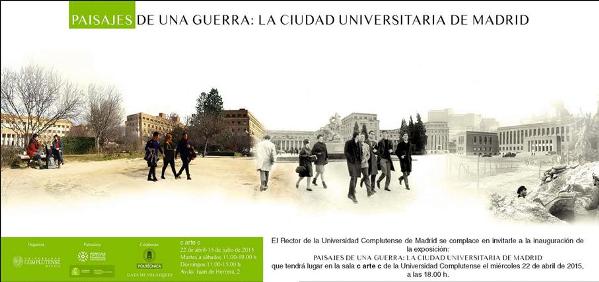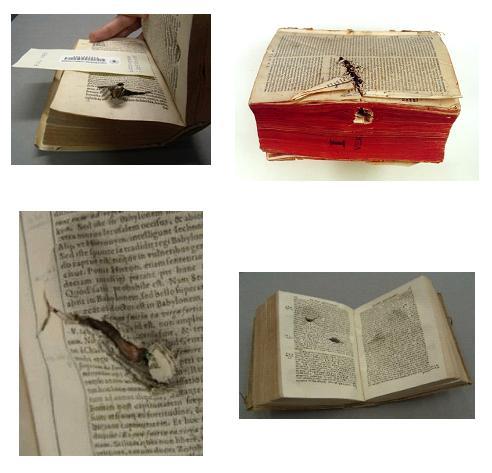La exposición estuvo expuesta bastante tiempo ( hasta el 15 de julio inicialmente ), y os recuerdo que había dos maquetas, una de ellas es la del estado en que quedó la Ciudad Universitaria después de la guerra. Para quien no la haya visto aún, es una auténtica gozada el nivel de detalle que tiene. Yo pude verla en otra exposición en el cuartel del Conde Duque hace ya años.

http://biblioteca.ucm.es/blogs/Foliocomplutense/9949.php#.VTiqzNKsX1N
Exposición «Paisajes de una guerra. La Ciudad Universitaria de Madrid», con la participación de la Biblioteca Histórica.
La Ciudad Universitaria antes, durante y después de la guerra era el objeto de la exposición «Paisajes de una guerra. La Ciudad Universitaria de Madrid«, un proyecto conjunto de las Universidades Complutense y Politécnica de Madrid, y el Campus de Excelencia Internacional Moncloa, junto con la Casa de Velázquez que se inauguró el miércoles 22 de abril, a las 18:00 h, en el centro de arte complutense ( Museo del Traje. Avenida Juan de Herrera, s/n). La Biblioteca Histórica ha participado con el préstamo de varios libros «con heridas de guerra» y valiosas fotografías históricas del campus de Moncloa y Ciudad Universitaria. La exposición permanecerá abierta al público hasta el 29 de noviembre. [Seguir leyendo]

En noviembre de 1936 la Ciudad Universitaria se convirtió en el teatro de operaciones de la denominada Batalla de Madrid. El terreno que empezaba a ser un campus universitario moderno y que era el centro de un gran proyecto nacional que combinaba novedad arquitectónica, diseño urbanístico y promoción educativa, con algunas facultades ya en funcionamiento, se convirtió en el escenario de un frente de guerra hasta marzo de 1939. Finalizada la guerra, hubo diversas propuestas para su reconstrucción, rediseño y reutilización. Con unos y otros proyectos, en los años 40 y 50 del siglo XX se inauguraron progresivamente los edificios que han ido otorgando al recinto su fisonomía actual. Durante un tiempo la actividad académica convivió con ruinas y huellas de la contienda; algunos de aquellos rastros aún pueden identificarse sin dificultad o rastrearse con algo más de paciencia.
La exposición se ocupaba de las dos grandes dimensiones del campus: el continente, como espacio cotidiano de universitarios y como espacio simbólico para las generaciones de la posguerra, y el contenido, marcado por sus habitantes y los testimonios aportados por el paso del tiempo. Estos dos grandes aspectos de la Ciudad Universitaria centraban la exposición, que muestra sus edificios emblemáticos, tanto los fácilmente identificables en la actualidad como los que nunca llegaron a verse ( por ser proyectos que nunca se realizaron) y los que ya no se ven ( porque la guerra y el tiempo acabaron con ellos). La exposición se ocupa también de quienes vivieron en Ciudad Universitaria experiencias sustanciales de sus vidas: arquitectos, estudiantes, combatientes, docentes…, a través de fotografías, planos, diseños, maquetas, fichas de alumnos, instrumental científico, libros afectados por la guerra, indumentaria y objetos hallados en las excavaciones posteriores a la contienda.

En la muestra se exhibían varios libros con restos de balas y metralla alojados en su interior, testigos mudos de lo ocurrido durante la Guerra Civil española en las batallas libradas en el frente de Madrid, con los que se pretendía mostrar los efectos devastadores de la guerra sobre el patrimonio bibliográfico de la Universidad Complutense, además de cerca de medio centenar de fotografías del campus de Moncloa y Ciudad Universitaria, un paseo a través de imágenes, y sensaciones, que reproducen la vida de los alumnos, fotografías directas de facultades y aulas, el momento de la inauguración del Pabellón de Gobierno, duras instantáneas del hospital Clínico destruido, trincheras, vistas aéreas de los terrenos… y muchos otras más, testimonio del periodo de los años 40-50 de la historia de la Universidad. Los libros expuestos son los que se detallan a continuación:
Duhamel du Monceau, Henri Louis. Art du serrurier. Paris : de l’imprimerie de L. F. Delatour, 1767. BH FLL 9814. Anotaciones manuscritas de soldado en hoja de guarda. Agustín, Santo. Diui Aurelii Augustini … Operum tomus primus . Venetiis : apud haeredes Melchioris Sessae, 1570. BH FLL12157. Agujero producido por arma blanca en el lateral, afectando al texto.
Fett, Andreas. Psalmus de profundis. Viennae & Brunae : apud Joann. Paul. Kraus …, 1735. BH FLL 6640. Atravesado por metralla.
Biblia magna : commentariorum literalium. Paris: Michaelis Soly … Matthaei Guillemot … Dionysii Bechet … et Antonii Bertier …, 1643. BH FLL 16471. Deteriorado por agujero producido por el impacto con un objeto puntiagudo.
Interpretatio chaldaica ab Esther ad Cantico canticorum. 1517. BH MSS 5. Manuscrito sobre pergamino. Deteriorado con daños exteriores.
Dionysius Cartusianus. Summae vitiorum & virtutum. Coloniae : excudebat Iohannes Soter, 1633. BH FLL 1439. Perforado por objeto puntiagudo y con casquillo.
Bordoni, Giuseppe Antonio. Discorsi per l’esercizio della buona morte. In Nizza : nella stamperia di Gabriele Floteront, 1760. BH FLL 4698. Agujero y cortes en el lomo. Guía de la Universidad de Madrid. 1944. BH ARC 4-1.
La muestra estaba organizada en cuatro secciones que podían verse siguiendo un doble recorrido. El primero, el recorrido cronológico, parte del proyecto inicial del campus desde 1927; nos llevaba a observar el desarrollo de la guerra y los testimonios de la misma; analiza la presencia de las ruinas y los procesos de reconstrucción siguientes y concluye señalando las huellas de la guerra en el campus e identificando los edificios que ya no podemos ver en él en nuestro 2015, es decir, los paisajes que vemos y los que no. El otro recorrido posible era el inverso: el que describiendo edificios actuales del campus, nos muestra cómo fueron esos edificios en fases anteriores, cuando fueron reconstruidos tras la guerra. En ellos se aprecian impactos y restos del conflicto que la reconstrucción dejó intactos, voluntariamente o no. Esos restos nos conducen a los escenarios de la guerra, al lugar que en ellos ocuparon los edificios que hoy vemos y al estado en que se quedaron. Solo podemos valorar la destrucción partiendo de cómo eran originalmente y para ello el recorrido nos lleva a las primeras construcciones del campus y a los edificios que allí hubo originariamente pero que en nuestro punto de partida de 2015 solo vemos en parte porque la guerra en algunos casos acabó con ellos.
En la exposición se exhibieron dos grandes maquetas. Una de ellas es especialmente emblemática: la maqueta que muestra, con unas dimensiones de 510 x 540 cm, el proyecto de la Ciudad Universitaria tal y como fue concebido en el año 1943. También podrá verse una maqueta de 490 x 510 cm, propiedad del Museo del Ejército y custodiada por la Universidad Complutense, que refleja el estado en que quedó el campus tras la Guerra Civil y que marca los terrenos surcados por las trincheras de uno y otro bando. En esta maqueta se aprecian los restos del primer diseño para el campus, junto con las ruinas que muestran el grado de destrucción en que quedó.
Carolina Rodríguez, profesora de Historia Contemporánea de la Universidad Complutense, fue la comisaria de la exposición, en la que colaboraron estudiantes del grado de Conservación de Restauración del Patrimonio Cultural de la Facultad de Bellas Artes, así como alumnos de la ETS de Arquitectura.
Los días 6, 7 y 8 de mayo de 2015, se celebró el coloquio internacional «Los paisajes de guerra. Huellas, reconstrucción, patrimonio (1939- años 2000), cuyo objetivo es confrontar, a partir del ejemplo de la Ciudad Universitaria de Madrid, varios tipos de paisajes de guerra resultantes de varios conflictos bélicos en la Europa del siglo pasado. Se insistió en el carácter comparativo y transnacional de esta historia particular de la reconstrucción después de conflictos, sin olvidarnos de la dimensión artística y cultural del fenómeno.
Las temáticas del coloquio se centraron sobre la experiencia bélica de las huellas de guerra ( ruinas, destrucciones, edificios de defensa, campos de batalla) tanto para los supervivientes como para las generaciones herederas. En segundo lugar, se interesaron por las políticas de memoria y las políticas de reconstrucción. Finalmente, se contemplaron el uso reciente de dichas huellas del pasado bélico, tanto turístico como patrimonial. En efecto, el valor patrimonial de los paisajes de guerra parece hoy ofrecer nuevas vías de reapropiación de las guerras lejanas, hasta presentar nuevas vías de presenciar el pasado en el presente.
Fuente: Universidad Complutense de Madrid y Biblioteca Histórica UCM.
Las bombas, granadas de mano, metralletas, explosiones… dejaron su huella sobre numerosos ejemplares, conservados ahora en los depósitos de la Biblioteca, convertidos en testigos de una cruel batalla: libros mutilados, hojas rasgadas por proyectiles y trozos de metralla alojados en su interior, con orificios de numerosos impactos de balas y huellas de armas blancas, libros deformados por derrumbes, manuscritos borrados y comidos por la humedad, el barro, semipodridos, abrasados…
Exposición “Balas y Letras: libros con heridas de guerra en la Biblioteca Histórica”. Organizada con motivo de la celebración del Día Internacional de la Paz ( 21 de septiembre de 2012 ).
https://webs.ucm.es/BUCM/blogs//Foliocomplutense/6416.php